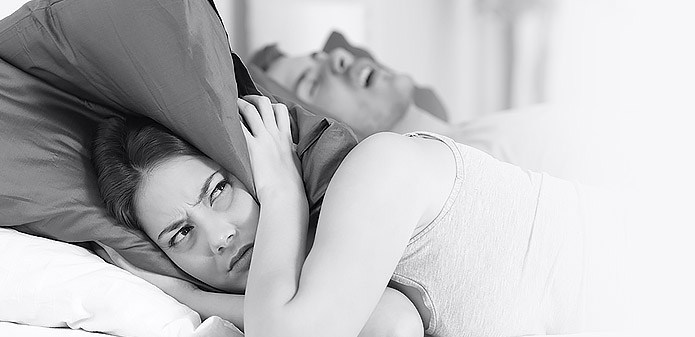
Sleep apnea is a serious and potentially life threatening sleep disorder that is defined by repeated pauses in breathing while asleep. The most common form of this condition is known as obstructive sleep apnea. This condition occurs when there is an obstruction of an individual’s airway, which as a result interferes with the flow of oxygen through the nose or mouth during sleep.
Obstructive sleep apnea is occurs when the muscles of the throat and mouth relax during sleep to the point where they fall back into the upper airway and create a blockage that restricts breathing.

To diagnose the disorder, a sleep study is typically conducted. The results of this study along with other medical findings will play a role in determining the recommended therapy. The most common form of therapy is a CPAP machine that is worn when sleeping. The CPAP device provides a steady stream of pressurized air into the respiratory system through a mask.
If mild to moderate sleep apnea is present, a dental appliance may be the recommended approach. Worn like a mouthguard or an orthodontic retainer, it is designed to help keep the tongue and soft tissues in the back of the throat from collapsing, thereby enabling the airway to stay open during sleep. An oral appliance is a good choice because it is easy to wear, easy to care for, comfortable, and portable. Oral appliances are custom fabricated, and made for both maximum effectiveness and comfort.
SCHEDULE YOUR APPOINTMENT TODAY! 513-370-5991
Symptoms of Sleep Apnea
Symptoms of this disorder include:
- loud snoring
- episodes of breathing cessation
- abrupt awakenings
- episodes of gasping for air
- and difficulty getting a good night’s sleep.
Not only will a patient show signs of problems during the night, but symptoms show up during the day, as well. Sleep apnea can cause a morning headache, excessive daytime sleepiness, difficulty concentrating, and irritability.

I am forever grateful for the passion of Dr. Gettings, Dr. Lee and the entire staff!
“I worked with Dr. Gettings to obtain a Prosomnus device as a last resort to solving long-term sleep difficulties. I had exhausted all other treatments including over the counter medications & devices, prescription medications, CPAP machines and anything and everything in between. I developed sleep problems, developing into apnea, 20+ years ago after requiring intense steroid treatments for an autoimmune disease and have never slept the same since. Nine months after starting use of the Prosomnus, my life has changed! I am sleeping 8 hours a night WITHOUT the use of any sleep aids that I would require prior. I have more energy throughout the day, waking up feeling refreshed, and my husband is sleeping better as well because my snoring has decreased as well as my tossing and turning. I am forever grateful for the passion of Dr. Gettings, Dr. Lee and the entire staff!”
Kristin Bramblett
Sleep Apnea Process
Sleep apnea can cause a patient to stop breathing up to hundreds of times per evening, for time periods ranging from 5 seconds to over a minute in length. While breathing is stopped, and oxygen is restricted to the heart and brain, the increased heart rate and stimulation causes the body to momentarily wake. This disruption in sleep pattern is what causes excessive daytime drowsiness and exhaustion in patients.

If left untreated, dangerous health complications can occur. The constant strain placed on the heart and brain, coupled with poor sleep quality and duration can result in serious health problems such as heart disease, stroke, mood disorders, and accidents related to daytime drowsiness.

Please consult with your dentist if you show signs and symptoms of obstructive sleep apnea.
Sleep Screenings
Know whether you’re getting the quality sleep you need to be at your best
Get the answers you are looking for with an easy, at-home sleep screening. It’s a simple device you wear on your finger for 2 nights while you sleep normally in your own bed. The data recorded on the device then get analyzed by a qualified sleep doctor, who will discuss their findings with you via a telemedicine appointment. You don’t even have to leave your home!
Once you know the results, you and your sleep physician can plan the course of action that is best for you, whether that means participating in a more detailed sleep study at a special facility or simply changing your sleep habits for optimal sleep quality.
You Have Options
If your sleep study reveals that you have OSA, there are treatment options.
- CPAP – the traditional treatment for sleep apnea, consisting of a mask that you wear over your nose and mouth while you sleep. Millions of people use CPAP every night for better quality sleep.
- Dental Appliance – As an alternative to CPAP, a dental appliance fits over your teeth, keeping your airway open while you sleep by ensuring that your jaw is always in the correct position to prevent obstruction. Dental appliances work for mild to moderate sleep apnea and for patients who cannot tolerate CPAP.
Talk to Dr. Gettings, your sleep medicine specialist, to learn more about getting your sleep screening today!
Real Patient, Real Results
“After suffering with sleep apnea for over twenty-five years, I had all but given up on finding a reasonable solution in correcting my condition. I have spent hundreds if not thousands of dollars experimenting with a number of CPAP machines and accessories to no avail.
At a recent dental visit, Dr. Gettings broached the topic of sleep apnea and a project that she had been working on with an oral appliance to help with sleep apnea. I was asked if I would be willing to participate and I reluctantly, due to past disappointment in correcting my condition relied on my trust in Dr. Gettings and agreed to do so.
I was fitted with the ProSomnus appliance and began to use it the night I received it. To my utter amazement, after two weeks of acclimating to wearing the appliance, my life changed significantly. I actually slept through the night after twenty-five years. My energy significantly increased to where I looked forward to getting up at 5Am to run three miles. My blood pressure lowered. My positivity in general increased to where I wake up in a great mood. Aches and pains in my neck and shoulders that were a daily nuisance have greatly reduced. And the best part, I can sleep once again in the same room with my wife of many years as she is now able to sleep through the night not having to suffer from the effects of my sleep apnea.
I applaud the fact that Dr. Gettings has taken dentistry to a new level in helping her patients like me with finding a solution to such a debilitating condition that so many people battle. This appliance isn’t just a game-changer, it’s a life-changer.”
Best regards.
Rob

